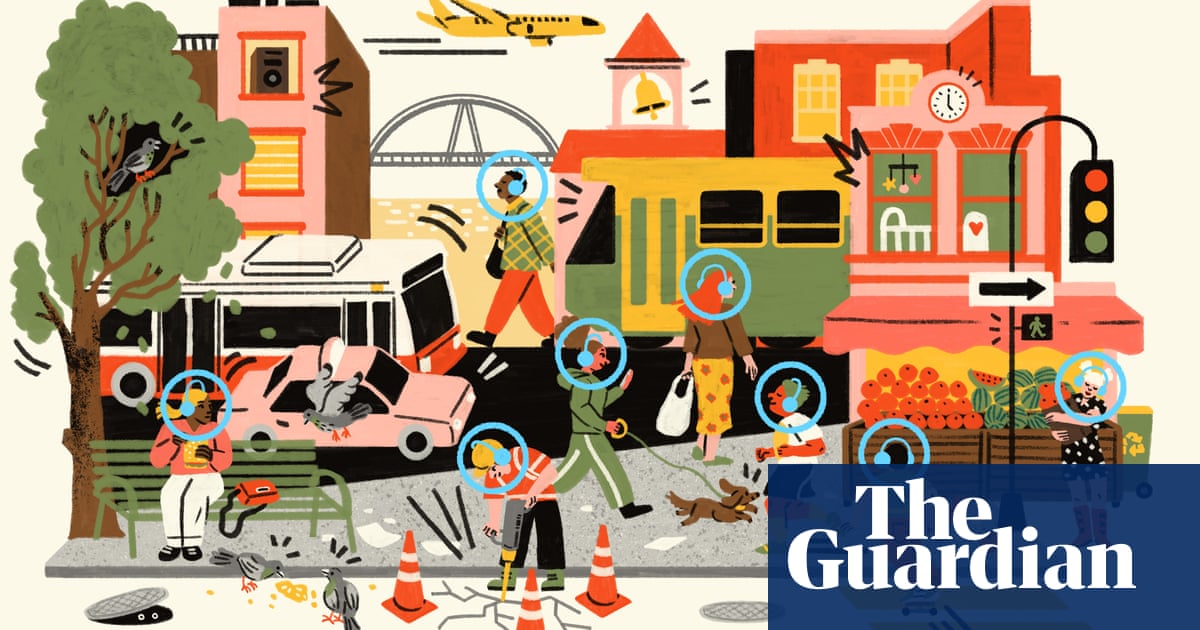
Everywhere you look, it seems, people are resorting to accessories to turn down the volume of life: over-ear headphones on public transport, long-haul flights and in open-plan offices; coloured earplugs nestled discreetly in the concha of concertgoers, bartenders and, if you’re a snorer, perhaps the person you share a bed with.
Silence is now big business: globally, the noise-cancelling headphones market generated $13.1bn in 2021, a figure that is expected to more than triple to $45.4bn by 2031, according to Allied Market Research data.
Google searches for “noise cancelling” and “earplugs” have steadily risen in Australia in the last five years, while earplug brands now spruik their aesthetic products as tools to help prevent “parental burnout” while caring for children. While market-based solutions are bountiful, they raise a question: are there physical and social costs to tuning out?
‘We are probably due a reckoning’
Noise-cancelling technology was first developed in the 1950s to reduce cockpit noise for pilots. The first commercially available headset, released by Bose in 1989, was also marketed for aviation.
The headphones use technology known as active noise control: a microphone picks up ambient sounds and an amplifier produces sound waves that are exactly out of phase. The result, when the opposite sound waves collide, is a cancelling out of noise. They work best for low-frequency sounds less than 1kHz, such as the roar of an aeroplane engine, the drone of road traffic or the hum of an air conditioning unit.
There is no question that too much noise is harmful to hearing, but also to broader physical health. Long-term noise pollution has been linked to increased risk of cardiovascular disease, including heart attack deaths, and depressive symptoms. Guidelines stipulate that workers should not be exposed to more than an average of 85dB of noise – about the sound level generated by blenders and leaf blowers – over eight hours.
“Every time you go up 3dB above 85dB, you have to halve the amount of time that you’re in that environment at work,” says Prof David McAlpine, the academic director of Macquarie University Hearing. “You could do four hours at 88dB and then two hours at 91, et cetera.”
There are certain situations where earplugs are necessary to prevent permanent hearing loss, McAlpine says: on building sites, in the military, at concerts or in loud work environments such as for cafe baristas.
But there are no such regulations around recreational noise. “Single doses of 100 to 105dB are enough to damage the neurons – the nerves – that attach to the sensory cells [in the ear],” he says. “Those nerves that are transmitting information about listening in noise are the first to go … and they are not detected in a clinical audiogram.”
Headphones can contribute, when listening volumes are too high, to hearing loss. McAlpine points to the irony of tech companies selling headphones, while also moving into the market of hearables – personal sound amplification products. “Apple AirPods have definitely been marketed this way,” he says. Research has found that AirPod Pro earbuds perform similarly to basic hearing aids in quiet environments. Another example of brand synergy is that Sennheiser’s consumer division is owned by Sonova, a hearing aid company.
Using noise cancelling can reduce the need to dial up the volume while listening in loud environments, which means in these instances it may be protective. By cutting down high ambient noise levels – such as when commuting on trains or during a flight – people use their headphones at volumes less likely to cause damage, research suggests.
But when it comes to noise reduction, too much of a good thing also has its downsides. Multiple studies have shown that constant earplug wearing, day and night, over just one week is enough to result in new-onset tinnitus. In one experiment, the tinnitus people developed was “perceived predominantly as high-pitched”, corresponding to the frequency range the earplugs were blocking.
“If you stop putting sound into your ears … your brain overcompensates by turning up its internal gain,” McAlpine says. “It completely alters your neural pathways – we know this. Monkeying around with the sound energy going into your ears is monkeying around with what your brain evolved to be doing.”
There is limited credible research on the benefits or harms of using earplugs or white noise machines when it comes to bedtime. “I think we are probably due a reckoning and certainly some evidence gathering on this,” McAlpine says. There is research, however, mainly from studies in hospital patients, that using earplugs at night can improve sleep quality in noisy environments.
‘It’s difficult to ignore speech’
But what to do if you struggle to block out the drone of an open-plan office? Noise-cancelling headphones are “the only way that I can effectively have an office door”, is something Libby Sander often hears.
Sander, an assistant professor of organisational behaviour at Bond University, says that before Covid, noise and disruption in open-plan offices was already a major issue for employees. The pandemic may have reframed people’s experiences of noise at work.
“I think people realised after we were working at home … that office noise and the distractions and interruptions were taken away,” Sander says. “People may not have been fully aware of how much it was impacting their productivity and their ability to concentrate and then found when they did go back to the office, it was a bit of a shock.”
Research that Sander co-authored has found that office noise can result in physiological stress and a subjectively worse mood. “We found that there was a causal link between a fairly inoffensive standard level of open-plan noise and the effect that was having both emotionally and physiologically on the people who were in the room,” she says.
When it comes to distraction, the type of noise may matter as much as volume. Moderate ambient noise, around 70dB, has been found to enhance performance on creative tasks, for example.
“Some people can work really effectively in buzzy cafes and even airports, and yet they can’t focus in the same way in an office. Even if it isn’t as noisy,” Sander says. “Your brain in the office is automatically attending to all those other conversations – because it might be about something you need to know.”
Densil Cabrera, an associate professor in audio and acoustics at the University of Sydney, agrees. “The way we listen to sound or attend to sound is to a large extent attuned to speech,” he says. “Because obviously human communication is important for humans, it’s difficult to ignore speech.”
His research has found that more speakers create greater distraction for those in open-plan office settings, regardless of volume. “One of the curious things is you could have loud speech or quiet speech and [the difference] doesn’t have a very big effect – both could be equally distracting,” Cabrera says.
Sander says noise-cancelling headphones can serve as a tool in the office, but broader solutions should involve designing workspaces with environments that serve varied purposes – for instance, dedicated areas for quiet concentrated work and different spaces for collaboration.
“Most people are not going to be able to do all of the different functions that they need to in a modern knowledge work environment at their desk.”
How, then, can we best navigate the clamorous distractions of modern life? An over-reliance on noise-cancelling technology is not necessarily the solution, says McAlpine. “We’ve simply outsourced our sound world in a way we’ve never outsourced our visual world,” he says. Imagine if all civic beautification efforts were replaced by individuals putting on AR/VR goggles, then walking around in their own private, alternative realities all day. “And that’s problematic.”












